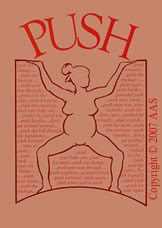THE PREGNANT PATIENT'S BILL OF RIGHTS
Many pregnant women are not fully aware of their right of informed consent or of the obstetricians' legal obligation to obtain their patient's informed consent prior to treatment. The American College of Obstetricians and Gynecologists (ACOG) first publicly acknowledged the physician's legal obligation to obtain his or her pregnant patient's informed consent in its 1974 publication, Standards for Obstetric-Gynecologic Services, (pg 66-67) which reads:
"It is important to note the distinction between 'consent' and 'informed consent'. Many physicians, because they do not realize there is a difference, believe they are free from liability if the patient consents to treatment. This is not true. The physician may still be liable if the patient's consent was not informed. In addition, the usual consent obtained by a hospital does not in any way release the physician from his legal duty of obtaining an informed consent from his patient.
"Most courts consider that the patient is 'informed' if the following information is given:
The processes contemplated by the physician as treatment, including whether the treatment is new or unusual.
The risks and hazards of the treatment,
The chances for recovery after treatment.
The necessity of the treatment.
The feasibility of alternative methods of treatment.
"One point on which courts do agree is that explanations must be given in such a way that the patient understands them. A physician cannot claim as a defense that he explained the procedure to the patient when he knew the patient did not understand. The physician has a duty to act with due care under the circumstances; this means he must be sure the patient understands what she is told.
"It should be emphasized that the following reasons are not sufficient to justify failure to inform:
That the patient may prefer not to be told the unpleasant possibilities regarding the treatment.
That full disclosure might suggest infinite dangers to a patient with an active imagination, thereby causing her to refuse treatment.
That the patient, on learning the risks involved, might rationally decline treatment. The right to decline is the specific fundamental right protected by the informed consent doctrine."
American parents are becoming increasingly aware that well-intentioned health professionals do not always have scientific data to support common American obstetrical practices, and that many of these practices are carried out primarily because they are part of medical and hospital tradition.
The distingquished obstetrician Dr. Roberto Caldeyro-Barcia, while President of FIGO, the world congress of obstetricians-gynecologists, cautioned two decades ago:
"In the last forty years many artificial practices have been introduced which have changed childbirth from a physiological event to a very complicated medical procedure in which all kinds of drugs are used and procedures carried out, sometimes unnecessarily, and many of them potentially damaging for the baby and even for the mother".
A growing body of research makes it alarmingly clear that every aspect of traditional American hospital care during labor and delivery must now be questioned as to its possible effect on the future well-being of both the obstetric patient and her unborn child.
There has been a three hundred percent increase in the rate of autistic children in the United States in just one decade. One in every 35 children born in the United States today will eventually be diagnosed as retarded; in 75% of these cases there is no familial or genetic predisposing factor. One in every 10 to 17 children has been found to have some form of brain dysfunction or learning disability requiring special treatment. Such statistics are not confined to the lower socioeconomic group but cut across all segments of American society.
New concerns are being raised by childbearing women because no one knows how drug induced changes in brain chemistry, oxygen depletion, head compression, traction and skull fracture by both forceps and vacuum extractor the fetus and newborn infant can tolerate before that child sustains permanent brain damage or dysfunction. The findings regarding the cancer-related drug diethylstilbestrol have alerted the public to the fact that neither the approval of a drug by the U.S. Food and Drug Administration nor the fact that a drug is prescribed by a physician serves as a guarantee that a drug or medication is safe for the mother or her unborn child. In fact, the American Academy of Pediatrics' Committee on Drugs has stated that there is no drug, whether prescription or over-the-counter remedy, which has been proven safe for the unborn child.
The Pregnant Patient has the right to participate in decisions involving her well-being and that of her unborn child, unless there is a clearcut medical emergency that prevents her participation. In addition to the rights set forth in the American Hospital Association's "Patient's Bill of Rights," the Pregnant Patient, because she represents TWO patients rather than one, should be recognized as having the additional rights listed below.
The Pregnant Patient has the right, prior to the administration of any drug or procedure, to be informed by the health professional caring for her of any potential direct or indirect effects, risks or hazards to herself or her unborn or newborn infant which may result from the use of a drug or procedure prescribed for or administered to her during pregnancy, labor, birth or lactation.
The Pregnant Patient has the right, prior to the proposed therapy, to be informed, not only of the benefits, risks and hazards of the proposed therapy but also of known alternative therapy, such as available childbirth education classes which could help to prepare the Pregnant Patient physically and mentally to cope with the discomfort or stress of pregnancy and birth. Such classes have been shown to reduce or eliminate the Pregnant Patient's need for drugs and obstetric intervention and should be offered to her early in her pregnancy in order that she may make a reasoned decisions.
The Pregnant Patient has the right, prior to the administration of any drug, to be informed by the health professional who is prescribing or administering the drug to her that any drug which she receives during pregnancy, labor and birth, no matter how or when the drug is taken or administered, may adversely affect her unborn baby, directly or indirectly, and that there is no drug or chemical which has been proven safe for the unborn child.
The Pregnant Patient has the right if Cesarean birth is anticipated, to be informed prior to the administration of any drug, and preferably prior to her hospitalization, that minimizing her intake of nonessential pre-operative medicine will benefit her baby.
The Pregnant Patient has the right, prior to the administration of a drug or procedure, to be informed of the areas of uncertainty if there is NO properly controlled follow-up research which has established the safety of the drug or procedure with regard to its on the fetus and the later physiological, mental and neurological development of the child. This caution applies to virtually all drugs and the vast majority of obstetric procedures.
The Pregnant Patient has the right, prior to the administration of any drug, to be informed of the brand name and generic name of the drug in order that she may advise the health professional of any past adverse reaction to the drug.
The Pregnant Patient has the right to determine for herself, without pressure from her attendant, whether she will or will not accept the risks inherent in the proposed treatment.
The Pregnant Patient has the right to know the name and qualifications of the individual administering a drug or procedure to her during labor or birth.
The Pregnant Patient has the right to be informed, prior to the administration of any procedure, whether that procedure is being administered to her because a) it is medically indicated, b) it is an elective procedure (for convenience, c) or for teaching purposes or research).
The Pregnant Patient has the right to be accompanied during the stress of labor and birth by someone she cares for, and to whom she looks for emotional comfort and encouragement.
The Pregnant Patient has the right after appropriate medical consultation to choose a position for labor and birth which is least stressful for her and her baby.
The Obstetric Patient has the right to have her baby cared for at her bedside if her baby is normal, and to feed her baby according to her baby's needs rather than according to the hospital regimen.
The Obstetric Patient has the right to be informed in writing of the name of the person who actually delivered her baby and the professional qualifications of that person. This information should also be on the birth certificate.
The Obstetric Patient has the right to be informed if there is any known or indicated aspect of her or her baby's care or condition which may cause her or her baby later difficulty or problems.
The Obstetric Patient has the right to have her and her baby's hospital- medical records complete, accurate and legible and to have their records, including nursing notes, retained by the hospital until the child reaches at least the age of majority, or, alternatively, to have the records offered to her before they are destroyed.
The Obstetric Patient, both during and after her hospital stay, has the right to have access to her complete hospital-medical records, including nursing notes, and to receive a copy upon payment of a reasonable fee and without incurring the expense of retaining an attorney.
It is the obstetric patient and her baby, not the health professional, who must sustain any trauma or injury resulting from the use of a drug or obstetric procedure. The observation of the rights listed above will not only permit the obstetric patient to participate in the decisions involving her and her baby's health care, but will help to protect the health professional and the hospital against litigation arising from resentment or misunderstanding on the part of the mother.
Prepared by Doris Haire ©2000
American Foundation for Maternal and Child Health








2 comments:
Wouldn't it be wonderful if these rights were respected? The OB who removed my placenta was annoyed that I wanted to know my options, rather than just letting him do whatever he wanted without telling me.
Love this!! Thank you for sharing the Pregnant Patient's Bill of Rights.
We, at Midwife International, wish to make these rights universally respected. We do this through training midwives who are equipped to work in resource-constrained regions where maternal and child mortality is high and the need for professional midwives is greatest in order to improve women’s health and birth outcomes by providing excellence in midwifery education.
For more information, please visit: http://midwifeinternational.org/midwife-training/.
Thank you for all that you do!
Post a Comment